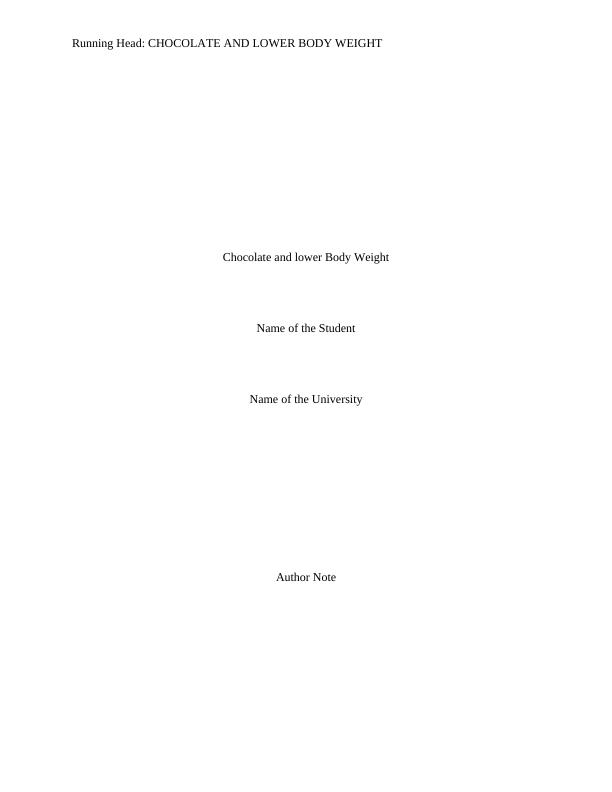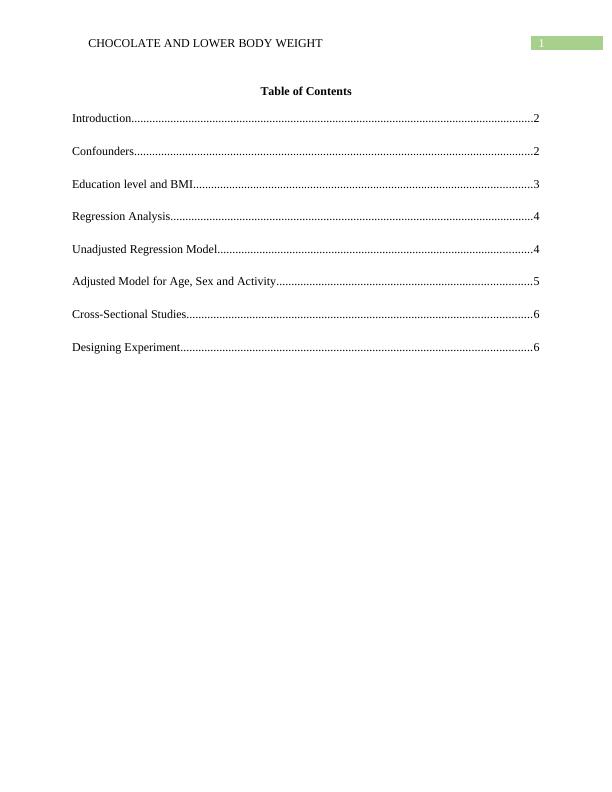Chocolate and Lower Body Weight - Doc
Added on 2020-04-21
11 Pages2620 Words220 Views
Running Head: CHOCOLATE AND LOWER BODY WEIGHTChocolate and lower Body WeightName of the StudentName of the UniversityAuthor Note

1CHOCOLATE AND LOWER BODY WEIGHTTable of ContentsIntroduction......................................................................................................................................2Confounders.....................................................................................................................................2Education level and BMI.................................................................................................................3Regression Analysis.........................................................................................................................4Unadjusted Regression Model.........................................................................................................4Adjusted Model for Age, Sex and Activity.....................................................................................5Cross-Sectional Studies...................................................................................................................6Designing Experiment.....................................................................................................................6

2CHOCOLATE AND LOWER BODY WEIGHTIntroductionThe aim of this research was to bring into light the various health effects of chocolate thatare beneficial. From various different studies, it has been observed that chocolate consumptionhas significant relationship with lower blood pressure, lower bad cholesterol, improved insulinsensitivity and reductions in the risks of diabetes, heart disease and stroke. This research has putinto light that chocolate is helpful in reducing body fat despite of the high calorific content. The data that has been used to conduct this study has been extracted from a clinical studywhich had examined the non-cardiac effects of cholesterol-lowering drugs in healthy adults. Theinformation of the variables that are included in the dataset are Body Mass Index (BMI),Frequency of chocolate consumption, Sex and age of the respondents, Frequency of physicalactivity, depression and some other dietary variables. With the help of the research conducted onthis data, the following information has been extracted. ConfoundersA variable which creates an outside influence and changes the effect of the independentvariable on the dependent variable is known as a confounding variable or a confounder. Thisexternal influence can alter the results of an experimental design. In other words, a confounder isa third variable which explains association of an outcome to an observed exposure. Thisassociation can be correct or even incorrect in some cases. With the help of a confoundervariable, association between two variables can be established when actually there is no relation.Thus, it can be said that an exposure which is unobserved can be associated with the exposure

3CHOCOLATE AND LOWER BODY WEIGHTwhich is of interest and affects the outcome which is of interest. Hence, confounders are one ofthe causes for biasness (Best & Kahn, 2016).The main aim of this research was to establish the effect of chocolate consumption onlower body weight. Thus, age and sex of the participants can be confounder variables. Accordingto the study, it has been observed that the relationship between chocolate consumption and BMIis negative with a significance of 0.008. Thus, it can be said chocolate consumption significantlyaffects BMI. It can also be observed that with the inclusion of age and sex of the individuals inthe model, the significance becomes 0.02. Thus, the significance is increasing and hence they areconfounder variables as it is changing the effect of chocolate consumption on BMI. Education level and BMIAccording to different studies, it has been observed that education level affects the BMIof an individual inversely (Golomb, Koperski & White, 2012). With the increase in the educationlevel, the BMI of an individual decreases. In this study, 58.8 percent of the subjects are collegegraduates. Thus, 58.8 percent of the subjects are high degree holders. Thus, if education isincluded in the model of predicting BMI, the result will give a much decreased BMI than usual.Thus, the model will be affected with the influence of education level. From this discussion, itcan be clearly stated that education have controlled the regression. Other possible variables that can control the regression model are calorie intake of anindividual and activities performed by an individual. More intake of calories is supposed toincrease the body weight of an individual and hence the BMI will be increased. Thus, inclusionof this variable in the model is supposed to influence the BMI. Similarly, activity performed by

End of preview
Want to access all the pages? Upload your documents or become a member.
Related Documents
Relationship between Body Mass Index and Asthma in Children and Adults: Case Study of New York Elementary School and Medical Clinicslg...
|6
|1499
|112
QUT XNH355 Assignment 3 Submission on Two Journal Articleslg...
|8
|3402
|297
Quantitative Analysis Reportlg...
|27
|3692
|60
Negative Impact of Fast Food in Children Assignment 2022lg...
|24
|4759
|15
Quantitative Data Analysis Reportlg...
|24
|3441
|1
Manipulating Dataset In SPSSlg...
|4
|661
|373
